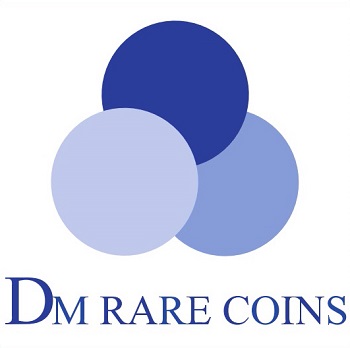March 9, 2017
Ancient Roman Overstrike:
Herennia Etruscilla Antoninianus Over
Gordian III Denarius Highlights Pragmatism
During Monetary Collapse

The recently-aired Netflix docudrama, Roman Empire: Reign of Blood, was dedicated to the crumbling of the Roman Empire under Commodus, AD 171-192. In the opening credits, the statues and structures of Rome are seen crumbling before the viewers’ eyes. The succession of Roman rulers was never an easy and rarely a bloodless process; but Commodus’ ineptitude began a downward spiral of chaos that would last 200 years. In AD 238, for instance, intrigue and mayhem would produce no less than six emperors. The only one to survive the year was 13 year old Gordian III. But in 244, he too was either murdered or killed in battle, likely conspired against by his adviser and eventual successor, Philip I (1). The exact truth is unknown. From 247 to 249, Philip I, and his son, Philip II, ruled jointly. They were both eliminated in 249 by Decius, who became Emperor Trajan Decius; declared “Trajan” by the people and the Senate; with his wife, Herennia Etruscilla (2). In AD 251, Decius and his son, Herennius Etruscus, both died in battle against northern invaders. Herennia’s surviving son, Hostilian, and Decius’ general, Trebonianus Gallus, became joint Emperors upon Decius' demise. Hostilian died almost immediately, and Gallus’ own son, Volusian, replaced Hostilian, becoming joint Emperor with Gallus. Both of these rulers were killed in battle in 253. Herennia Etruscilla lived until 254. If that was a little confusing, our point was accomplished. (3)
As a result, the Denarius held less and less purchasing power. It was actually during the reign of Gordian III, AD 238-244, that the legendary Roman Denarius was finally discontinued, altogether, in favor of the more useful Double Denarius, properly known as an Antoninianus. Yet, even this new denomination had its shortcomings. In fact, due to significant weight variances; a Double Denarius was not always heavier than a single Denarius. Sometimes, the only way to tell what denomination you have is by the design used. By the end of the 3rd Century, silver would be completely, and openly, eliminated from the smaller Roman denominations, in favor of new bronze and brass denominations.

RIC 55b:
HER ETRUSCILLA AVG
“Bust, diademed, draped, on crescent, r[ight]

FECVNDITAS AVG
“Fecunditas st[anding left], holding r[ight] hand over child st[anding] r[ight], with hands raised, and cornucopiae (sic) in l[eft] hand” (5)






(Courtesy of Heritage Galleries)
RIC 127 seems as though it could be a match, but we must
explore a second option; if for no other reason than its similar style; and the only other Denarius to show a centrally located pole; Gordian Holding Spear and Globe,
RIC 115. This design was part of Gordian’s dated coinage, and reads “P.M.
TR. P. III COS. II P.P.;” the "Cos. II" corresponding to Gordian's second Consulship, beginning January AD 241. (12)
It appears on both single and Double Denarii. Unfortunately, no fragments of the Gordian III reverse legend are visible to decipher. Further, no clear remnants of the front end of the shaft remain to determine whether it ends in a flame or a barbed spearhead.

(Courtesy of Heritage Galleries)




Finally, we do not want to overlook the quality of the present piece. As far as over-struck Greek and Roman coinage goes, it is superb. The surfaces display their original “find patina” and have not been cleaned or stripped like so many other examples from this period. It even shows nice original luster under the attractive toning. Moreover, the Gordian III under-type survived the striking process remarkably well, despite a very sharp, high relief strike of the Herennia design, over-top. The only strike deficiency of note is a gulf between Fecunditas’ knees and feet, where the high relief profile of Gordian III prevented her legs from showing up completely. However, this anomaly was a blessing, enabling the face of young Emperor Gordian III to show through, unscathed, even after almost 2000 years.
Image Gallery:
Footnotes & Bibliography
1) The Roman Imperial Coinage: Gordian III – Uranus Antoninus. Ed. by Harold Mattingly, Edward A Sydenham, C.H.V. Sutherland. Volume 4, Part III. London; Spink and Son, LTD. 1949 (p 10). https://archive.org/stream/zingadula_20140203/RIC%204-C#page/n45/mode/2up (January 2017)
2) ibid, 113.
3) https://www.britannica.com/biography/Gordian-III
https://en.wikipedia.org/wiki/Gordian_III
https://en.wikipedia.org/wiki/Philippus_II
https://en.wikipedia.org/wiki/Decius
https://en.wikipedia.org/wiki/Volusianus
https://en.wikipedia.org/wiki/Trebonianus_Gallus
4) RIC, 10.
5) ibid, 127.
6) ibid, 115
7) ibid, 22, 27, 28.
8) ibid, 10-11.
9) ibid, 47.
10) “The weight of the coinage is indicated by the two dated types. It was slight in the months January to July 241, very heavy throughout 241-242, and still heavy in 242-3, again light in A.D. 243-4.” ibid, 10
11) ibid, 10.
12) ibid, 24-25, 27-28.
13) ibid, 25.
All Gordian III coin images used with permission from Heritage Auction Galleries:
